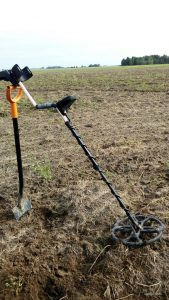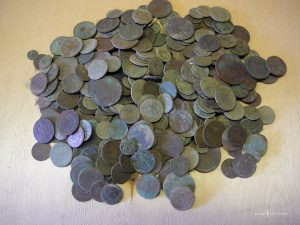Fisher F70 settings, functions, features. Advice for novice treasure hunters
Lately, people regularly contact me on various forums asking me to tell me at least something about the characteristics of the Fisher F70 metal detector. As a rule, these are beginner hackers who have little understanding of the functionality and advantages of a particular MD. I myself was once like this, I myself could not understand the difference between a device for 20 thousand rubles and a device for 80 thousand. And when I chose my device, I was primarily guided by reviews on the Internet, videos and other review articles . And if, for example, on ACE 250 there is an abundance of content and all kinds of accompanying material on the network, then for Fisher F70 there was practically nothing in the Russian-language segment of the Internet. Instructions for use and several short standard descriptions on online store websites. Therefore, I decided to write a short review of the Fisher F70 based on operating experience over three seasons.

The Fisher F70 MD is classified as semi-professional, what this means is not entirely clear, but most likely this is a marketing ploy, just as computers were once divided by the number on the microprocessor or the number of cores on the same processor. It’s easier for a simple novice hacker to understand why the cost of one MD is three times more than the cost of another. In fairness, I note that I had the opportunity to test several “amateur” class devices in operation, the verdict is unequivocal – it’s better no matter what, instead of no matter what. But here everyone has to decide for themselves. It happens that they buy a device to check their grandfather’s legend about a treasure in a neighbor’s garden, and when instead of the treasure there are two buckets of rusty iron, then many treasure hunters quickly cool down and the device becomes part of the interior like a food processor or an exercise bike.
I, like many who decided to buy a device for the first time, was extremely limited in funds; moreover, my wife also had to develop a whole theory of justification for why we should spend the reserve fund of family savings on incomprehensible nonsense. But I’ll write about this another time. When choosing the device that I want to buy, for the first time I had to read the information for a long time and persistently. For the most part, there were advertising materials, very similar to what I am writing now, only there are more delightful epithets and examples of successful expensive finds in the text than necessary. But there is little real understanding of the essence of superiority.
Let's start with the most important indicator for any metal detector – detection depth . Everywhere, in all product characteristics, in descriptions and comments to them, this term is present. Everyone writes about the increased coefficient, or the overall increased depth, or the depth is measured in centimeters, but measurements in centimeters cannot be seen from the officials or in the instructions. Why? Because this is a relative value. The depth of target detection directly depends on the condition of the soil, its density, humidity, mineralization, and groundwater level in the spring, when the snow has melted. There are a great many videos where they test detection depth using the air or ground method. You can trust these videos with a relative degree of conditional trust. Since the videos can simply be custom-made by one or another manufacturer.
So , the detection depth on the Fisher F70 is adjusted by two modes in the settings panel. This is Threshold, which translates as threshold, and sensitive – sensitivity. The coil of any MD is both a signal emitter and an antenna receiving this signal. Threshold is the strength of the emitted signal, sensitive is the sensitivity. Interestingly, on the Fisher F75 these two indicators are divided between two modes and cannot interact with each other. What does this look like in practice? I went out into the field, turned on the device, and looked at the quality of the soil. If the soil is dense, for example, dead grass or a mown meadow, then I set Threshold to (-2), and set sensitive until the device starts to “grunt” from scratch, then I remove the sensitivity. by 3-4 points and start the search. If the soil is loose or it is a forest, then Threshold is at (0) and the same operation with sensitivity. In general, I consider my favorite settings to be 70-75 sensitivity and threshold (-1). In the instructions for use of the device it is written that threshold is a mode for cutting off targets by size. Well, something like the fact that when you set it to maximum (9), the smallest targets at the greatest depth will be visible. I tried this, it’s still the same fork, if you set threshold to maximum, then you need to set sensitivity to minimum. As I understand it, this regime was introduced to attract the attention of gold miners in the American and Australian markets. For us, this can be useful only if you find a place to plow up the silver scales.

Ground balancing . This is a procedure for detuning the device from possible interference in the ground. Well, for example, the soil has high mineralization, and the device can emit light from this. To be honest, for the first six months I used the device without this at all. Then I started doing it, but more to calm my conscience. Attention!!! The instructions for the device say that to balance it is enough to raise and lower the coil above the ground three times while holding the corresponding button. In my practice, this has never happened. As a rule, you have to wave the device ten times until the ground balance numbers change on the screen. At first it’s 90, and then, when the device is adjusted, it’s somewhere around 50. Sometimes I had to cancel the adjustment when, after 20 strokes, the numbers did not change, but after some time I repeated the procedure, and the adjustment was always successful.
Discrimination mode is the second most important function of the device. In principle, this is what distinguishes professional MD and devices for beginners. One of my friends borrowed a budget segment device from a friend for the weekend to walk around his garden. In 4 hours, the persistent cop collected about twenty kilograms of various iron. Although the device had a discrimination mode, budget models almost always mistake wrought iron for a color signal. The Fisher F70's signal separation is great. The exception is ringed black stuff, all kinds of rings, parts from agricultural machinery and lemonade lids. Although yes, the device produces a double range and with a high degree of probability you can understand that this is a cover, but I still dig, according to the principle, what if. In plowed fields I walk with the separation from ferrous metals set to 12, in the forest I set it to 0. I don’t like the “all metals” mode, I get tired very quickly mentally and it’s boring from the monotony. Whereas any high signal always gives a good adrenaline rush.
The review of the device’s functions could be completed here, because all other functions are used either very rarely or are completely useless. For example, memory for two programs. One of the features of the Fisher F70 is the ability to preset two different programs and with the press of one button you can switch between them. For example, program 1 is a standard search with cutting off black signals, and program 2 is all metals. I did this, I’ll say frankly – it was all self-indulgence. Because in littered areas, such as a vegetable garden or a plowed-up village of the 20th century, you still walk without discrimination, but in a field, if you have a color signal, it will not disappear anywhere.
Sound tone. This is also not a very functional tab in the device menu. As I understand it, she switched to the 70th from the flagship model F75. Marketers correctly calculated that if the buyer of a new device had previously used a model from another manufacturer, then he would be pleased to work with the device, having familiar sound tones. Here everything is like with fishermen, if from childhood you are accustomed to responding to the sound of a copper bell, then you don’t really like Chinese bells. Therefore, if you choose the Fisher F70 as your first device, then leave the standard H3 audio tone.

Button for changing electromagnetic frequencies. Over the three years of operation, I used this mode no more than five times. This is when friends came with a Fisher F75. Three of my comrades have the 75th, and when we go out into the field as a whole team, the devices begin to catch each other. The ability to change the frequency is very useful. In general, F70 has very good stability against the influence of third-party electromagnetic radiation. Primarily from a mobile phone. It happens that during the cop period you are waiting for a very important call or message, this is especially true if you work as a freelancer. So you can’t turn off your cell phone, and I’ve seen how budget MDs go crazy if the user doesn’t turn off his cell phone. With the F70, you can safely carry your phone in your breast pocket, the only exception is in the forest when, having lost the network, the mobile phone starts phoning, and then I switch it to “airplane” mode.
Speed mode , two main options dE – default and SL – slow. I use this option quite often, especially when the signal disappears after digging in a plowed field. The target may go to the bottom of the hole, so I check it on a slow retrieve with increased depth. Always walk on a slow retrieve, I also tried it on a forest clearing. I didn’t see much difference between the standard mode and the maximum sensitivity setting in the standard mode. When switching to slow mode, the device begins to catch phantoms and you simply have to reduce the sensitivity.
PIN POINT button . I had a chance to use this button for the first month after purchasing the device. Subsequently, the skill of understanding the center of the target is developed based on the analysis of the sound signal; when the center of the coil passes, the sound is loudest. Subsequently, when a large 13-inch coil was installed on the device, I learned to determine the center of the target along the edge of the coil, but this method will be discussed in the next article. And in general, over time, the sight begins to automatically catch sight of finds in a lump of soil. But you need to buy a separate manual pinpointer. Personally, I realized this after searching for half a GRP in the clay slurry for about ten minutes.
The NOTCH function is an absolutely useless option on the device for a user who digs in the old days and here’s why. Fisher F75-F70, like the entire line of MDs from this manufacturer, was initially focused on the needs and preferences of American and Australian users. In Australia they are prospectors, in the USA they are also prospectors and diggers in the old days. But in the old days they have their own peculiarity. The cultural layer is only 100-150 years old, that is, the depth is no more than 15 cm. And American comrades are digging mainly in old abandoned towns. And this is a very large amount of colored garbage. Just like in our country, they are looking for lost change, but American change has its own characteristics in terms of metals.

Using this table, a digger from the USA can configure the device to cut off all supposed junk signals, for example aluminum reeds. In the vastness of the Central Russian plain, such an example of signal discrimination is absolutely useless. We have all historical metal-plastic, can give a signal from 15 to the very limit. Tin, pewter bronze, bronze, thinned silver, copper and of course zloty jewelry. If anyone doesn’t know, gold jewelry, depending on the purity, is displayed in a spectrum from 50 to 65. Therefore, Russian MD users dig all color signals.
Signal detection depth. Depends entirely on the size of the target and the search mode you choose. However, there are average parameters. I won’t mention the barrel hoop that I pulled out from a depth of a meter, the steering wheel from a tractor, or the manhole cover from a tractor from a depth of 1.5 meters. Let's take standard finds in the form of coins. For the first six months I went with a standard F70 coil, then I bought a Nel Tornado; a review of working with these and other coils will be in a separate article. So, a standard 10″ Elliptical for FISHER F70 (F70COIL). This is a monocoil, so it has a very decent signal detection depth; Alexander 1 sees standard money and 2 kopecks at a depth of up to the fiskar’s bayonet. Katya's nickel was found at a depth of 1.3 bayonets; it also sees small targets like scales well. However, the small area of action of the coil will force you to walk in one area for a long time, persistently and possibly ineffectively.
At the same time, I strongly recommend buying a device complete with this particular coil, and there are two reasons for this. As practice has shown, the first place for digging for most novice comrades is the garden in the village. High density of all kinds of metal debris. Especially where there was a barn or bathhouse, and this is simply the natural element for the FISHER F70 with the F70COIL coil. The first two days of the cop are subsequently decided. Will this remain a hobby or will the device lie on the mezzanine for a long time until the owner decides to sell it at half price. The second reason for choosing a mono coil is that it is perfect as a sniper, for digging, and over time, when you get to this difficult, but very interesting type of digging, you will not have to buy a separate coil for this activity.

Why did I choose this particular device? Well, for two reasons. The first one is because. that my first device, which a friend left me for a while to try whether I liked it or not, was a Fisher F75. When the time came and the device was returned to the owner, I sincerely wanted to buy the same one, but finances were limited and when choosing analogues, I settled on Fisher. And the second reason was the ability to equip the device with various types of coils, a huge selection of different models from all manufacturers, coils from F75 are suitable for F70. In fact, individual coils make it possible to gradually turn a semi-professional device into a device that in many respects is superior to professional models two to three times more expensive than the F70. In conclusion, I would like to note the incredible strength and reliability of the device. I use it harshly, in the trunk of a car, it shakes and falls from a shovel, hitting the block with a shovel, dirt, dust, humidity, snow, winter pit at -18, summer heat. In three years he worked for me as much as for an ordinary digger in ten years. A reliable and worthy device in its price segment. My advice you won't regret.
Author: Iskatel Local historian
